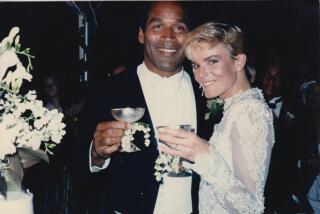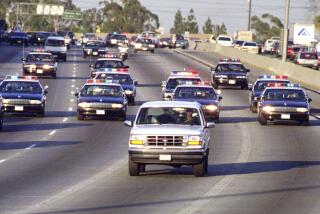Column: Barry Scheck on the O.J. trial, DNA evidence and the Innocence Project
The O.J. Simpson case, which began to unfold 20 years ago this month, was a blip — a significant one, but a blip — in Barry Scheck’s legal career. Scheck is now better known as co-founder of the Innocence Project, the not-for-profit dedicated to using DNA evidence to free the innocent from prison, sometimes even from death row. Its work, and that of related efforts in 40 states, have resulted in 316 post-conviction exonerations. Two years after Scheck and Peter Neufeld started the Innocence Project in 1992, they were called upon to deploy their expertise in DNA evidence and its collection by the Simpson defense team. The trial, inlcuding Scheck’s cross-examination of LAPD criminalists, riveted the world and wrought changes in the justice system.
What did the O.J. trial change?
It was a watershed case, but not in ways that people suspect. We did not challenge the underlying reliability of DNA testing methods; we attacked the way that evidence was gathered and processed. We had a 21st century technology and 19th century evidence collection methods.
The theory about the degradation of crime scene samples — putting wet swabs in plastic bags and then putting them in a hot truck for seven hours would degrade the DNA; there could be no real argument. When the samples from the crime scene — the glove, the blood drops — were all put on the table by [LAPD criminalist Collin] Yamauchi, and he wasn’t sure he changed his gloves when he touched each different sample and did DNA testing, that kind of cross-contamination by today’s standards is mind-blowing. The DNA prosecutors, on the other side — the late Woody Clarke and Rockne Harmon — knew that.
Later, Clarke and I were on a commission on the future of DNA evidence. The FBI issued a circular saying what every law enforcement officer ought to know about DNA testing and crime scene collection. That memo might as well have been subtitled “What to Do and not Do Based on the Lessons Learned From the O.J. Simpson Case.”
Did the law as well as crime scene practices change as a consequence?
Clarke was instrumental in helping us pass a DNA statute in California that allowed for post-conviction DNA testing [of evidence]. The statute was intended to ask the question first, “If we do a DNA test on anything left at the crime scene that might contain biology from the person who committed the crime, would the DNA — which could exclude [the suspect] but also link another person law enforcement doesn’t know about to that crime — would it create a reasonable probability of a different outcome?” Case law has developed in California [such that] courts will not assume that DNA results will [make a difference]. Efforts are being made to go back to the state Legislature.
One thing that wasn’t developed at the time of the Simpson case is CODIS, the DNA databank. Let’s say there is a mask left at a crime scene and testing excludes the defendant. There ought to be a clear statutory right to get a DNA profile [from it] put in the databank in hopes of identifying the real perpetrator. In California, a defendant doesn’t have [that] statutory right.
There’s still the difficulty of presenting complex DNA evidence to jurors.
In the Simpson case, some issues — the mixtures and statistics— seemed complicated at the time, but the key points about cross-contamination were very straightforward. That’s why it did change the way people [now collect] crime scene evidence.
What about other consequences of the case?
The Simpson case first of all did nothing good that I can see for race relations in the United States; it exacerbated what was a continuing problem. But worse than anything is what it did for coverage of trials. Court TV, when Steve Brill began it, was an extraordinarily serious enterprise. I worked with them in the creation of best practices for legal commentators. There was an effort to professionalize the coverage.
The Simpson case began to wreck all that, when people discovered this was great television, and a great national circus. Now we are in the era of Nancy Grace. Some trial captures the national imagination — not because it has any particularly important issues but in a tabloid way — and you get all these talking heads babbling in the most incendiary way. I represented one of the young men in the Duke lacrosse case, and I actually heard a commentator say [with no evidence], “I think all these young men were sexually abused by their parents!”
In terms of how journalists — particularly television journalists — cover trials, the case undermined the image of justice.
Attorneys and judges complain about the “CSI effect,” that juries now expect TV-like precision and swiftness.
Social scientists who have studied it find it doesn’t really exist, is a minor effect, the notion that juries are expecting people to come in with all this high-falutin’ forensic science.
What’s upsetting is that when unvalidated forensic science is brought into court, it has been admitted in ways the National Academy of Sciences said is really a crisis. Only DNA has been validated, and all these [other] disciplines haven’t, any more than astrology. Courts for too long have not been adequately scrutinizing the scientific evidence to make sure it was valid. Now that’s beginning to happen.
In many ways the Simpson case was unique, but people look at it as representative. It did underline the fact that the system works better for people with money.
That is true. We’ve probably had the least reform in the criminal justice system in the financing of criminal defense for the indigent. That hurts everyone because a good public defender performs extraordinarily important functions. They protect the innocent. A vigorous defender means scientific evidence gets scrutinized adequately, police officers and prosecutors who cross the line will get exposed. [When] defense attorneys don’t have the money or ability to challenge evidence adequately, it doesn’t just hurt innocent defendants, it allows guilty people to go free.
How did the Simpson case affect the Innocence Project?
That’s a tough one to figure. On the one hand, we knew the whole innocence movement would be really significant. DNA would be able to demonstrate that a lot of innocent people had been convicted, and identify people who had really committed the crime. But we also knew it would expose all kinds of problems: the [questionable] reliability of the confession, prosecutorial and police misconduct, jailhouse informants — all of these matters have been exposed by the innocence movement. The Simpson case in that way may have muddied the message.
On the other hand, there were, frankly, uses that can be made of celebrity. After watching this trial, people understood that we had this technology in forensic matters. People did pay attention. Prosecutors and law enforcement took it very seriously. Fame is a good thing to have sometimes if you can put it to good use. The Innocence Project benefited from that.
Did it alter your life?
It is very odd to become somebody that millions of people watch on television and develop all kinds of crazy views about. But at the same time, there was a view certainly in the African American community that it was good that Mr. Simpson got a good defense, and people thought it was important. When you have the opportunity to be in the public spotlight in America, you’ve got to make good use of that. People recognize me now more for the work of the Innocence Project.
What were you doing during the white Bronco car chase?
I was in Madison Square Garden at the [NBA] playoffs. If you went to the concession stand, you could see it. I watched the game. But as soon as I saw the Bronco going around, I had a feeling we would be called.
This interview was edited and excerpted from a tape transcript. patt.morrison@latimes.com Twitter: @pattmlatimes
More to Read
A cure for the common opinion
Get thought-provoking perspectives with our weekly newsletter.
You may occasionally receive promotional content from the Los Angeles Times.







